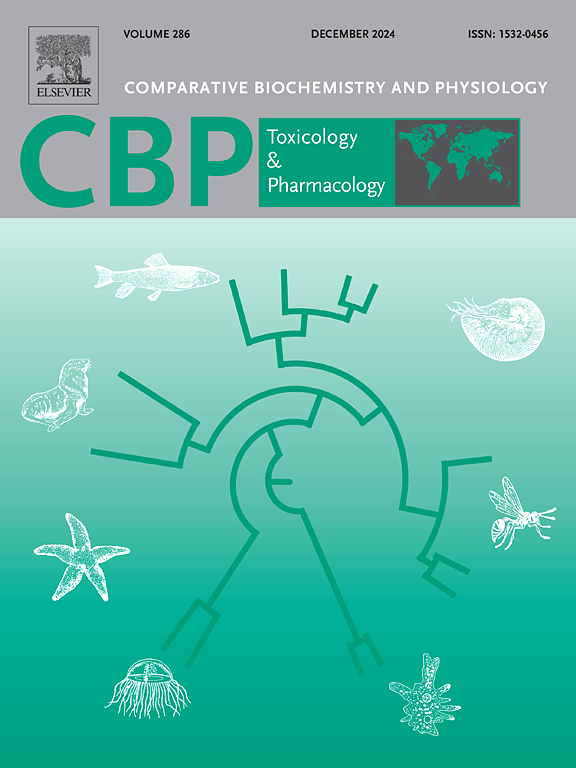PCB153 induces epileptic-like behaviors in zebrafish by disrupting the GABA pathway
IF 3.9
3区 环境科学与生态学
Q2 BIOCHEMISTRY & MOLECULAR BIOLOGY
Comparative Biochemistry and Physiology C-toxicology & Pharmacology
Pub Date : 2025-05-26
DOI:10.1016/j.cbpc.2025.110230
引用次数: 0
Abstract
Polychlorinated biphenyls (PCBs), as persistent organic pollutants, have raised widespread concerns regarding their environmental and biological impacts. This study aims to investigate the effects of PCB153 exposure on the zebrafish nervous system, particularly its potential mechanism in inducing epileptic-like behaviors. Zebrafish at 6 h post-fertilization (hpf) were exposed to PCB153 solutions at concentrations of 1 μM, 5 μM, and 10 μM via waterborne exposure. The results indicated that PCB153 exposure significantly altered zebrafish locomotor activity and light/dark transition behaviors, with a marked presence of epileptic-like behaviors, especially in the high-concentration groups (5 μM and 10 μM). Further molecular analysis revealed that PCB153 exposure led to alterations in the expression of genes related to the GABAergic signaling pathway, particularly the upregulation of gad2 and the downregulation of GABA receptor genes. These findings suggest that PCB153 may disrupt the GABA system, resulting in an imbalance between excitation and inhibition in the nervous system, thus triggering epileptic-like behaviors. Additionally, treatment with SAHA (histone deacetylase inhibitor) showed neuroprotective effects, alleviating the epileptic-like behaviors induced by PCB153. Transcriptome sequencing further identified extensive changes in gene expression, predominantly in pathways associated with neuronal function and development. In conclusion, PCB153 exposure disrupts the GABAergic neurotransmitter system, which may be a key mechanism underlying the epileptic-like behaviors in zebrafish, and SAHA treatment could potentially have therapeutic effects. This study provides new insights into the toxic effects of environmental pollutants on the nervous system and offers experimental evidence for future neuroprotective strategy research.

PCB153通过破坏GABA通路诱导斑马鱼的癫痫样行为
多氯联苯作为一种持久性有机污染物,其对环境和生物的影响已引起广泛关注。本研究旨在探讨PCB153暴露对斑马鱼神经系统的影响,特别是其诱发癫痫样行为的潜在机制。将受精后6 h的斑马鱼分别暴露于浓度为1 μM、5 μM和10 μM的PCB153溶液中。结果表明,PCB153暴露显著改变了斑马鱼的运动活动和明暗转换行为,并表现出明显的癫痫样行为,特别是在高浓度组(5 μM和10 μM)。进一步的分子分析表明,PCB153暴露导致GABA能信号通路相关基因的表达改变,特别是gad2的上调和GABA受体基因的下调。这些发现提示PCB153可能破坏GABA系统,导致神经系统兴奋和抑制之间的不平衡,从而引发类似癫痫的行为。此外,SAHA(组蛋白去乙酰化酶抑制剂)治疗显示神经保护作用,减轻PCB153诱导的癫痫样行为。转录组测序进一步确定了基因表达的广泛变化,主要是在与神经元功能和发育相关的途径中。总之,PCB153暴露会破坏gaba能神经递质系统,这可能是斑马鱼癫痫样行为的关键机制,SAHA治疗可能具有潜在的治疗作用。本研究为了解环境污染物对神经系统的毒性作用提供了新的见解,并为未来神经保护策略的研究提供了实验依据。
本文章由计算机程序翻译,如有差异,请以英文原文为准。
求助全文
约1分钟内获得全文
求助全文
来源期刊
CiteScore
7.50
自引率
5.10%
发文量
206
审稿时长
30 days
期刊介绍:
Part C: Toxicology and Pharmacology. This journal is concerned with chemical and drug action at different levels of organization, biotransformation of xenobiotics, mechanisms of toxicity, including reactive oxygen species and carcinogenesis, endocrine disruptors, natural products chemistry, and signal transduction with a molecular approach to these fields.

 求助内容:
求助内容: 应助结果提醒方式:
应助结果提醒方式:


